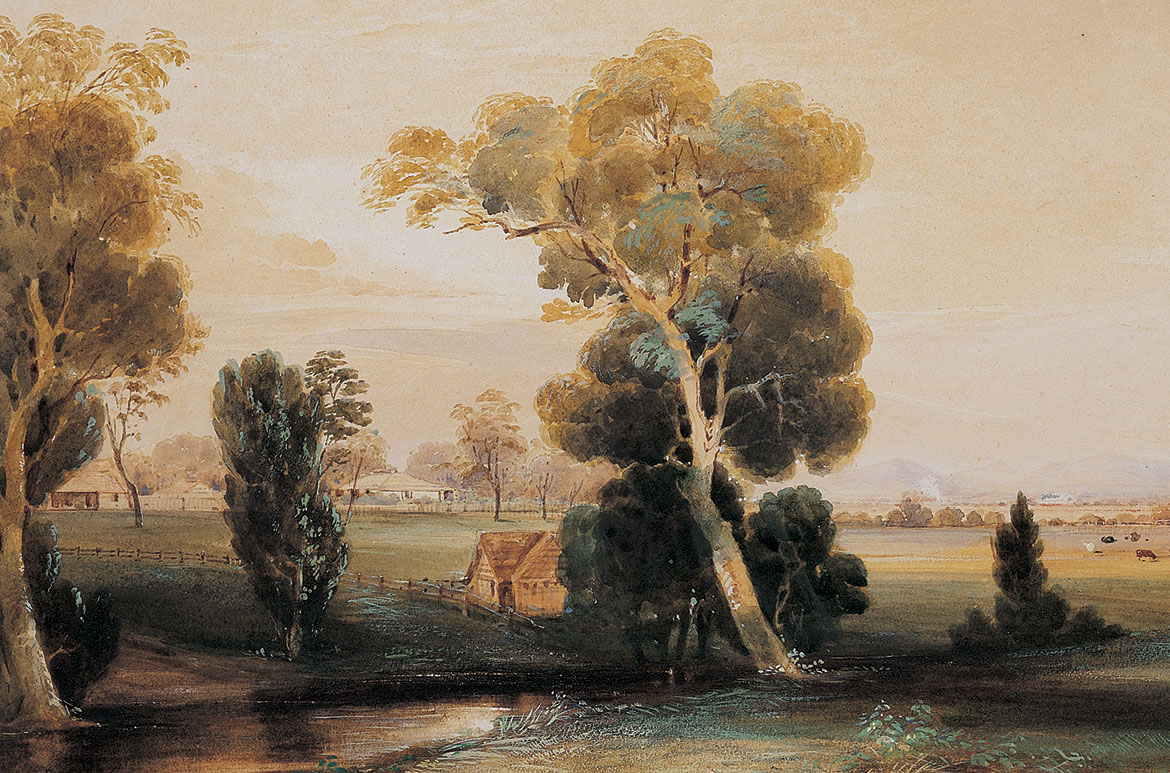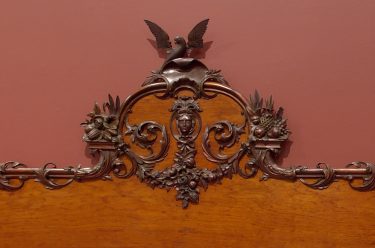Watercolours feature in the earliest records of European exploration and settlement of Australia. Its continuous presence in the history of Queensland art has changed and evolved with shifts in culture, as well as with the demands and innovations of its practitioners. We look at the medium’s important role in enriching Queensland’s visual history.
Together with drawing, watercolour was the logical choice for the first artistic works of Europeans for Australian subjects and, accordingly, its practitioners were often explorers, professional artists accompanying expeditions, or those trained in a profession such as architecture, surveying or engineering. Indeed being a draftsman was considered one of the requirements of an adequate education. Watercolour was most often the medium of choice for documenting the early years of settlement during the colonial era, chosen for its ability to record fine detail and favoured for its immediacy and vibrancy, portability and convenience.
These qualities were most admirably expressed in the work of Conrad Martens (1801–78), who travelled to the Darling Downs in the early 1850s. Martens was the first professional artist to paint in Brisbane, and his paintings are the earliest comprehensive visual records of the area.
Martens’s drawings and paintings of the Darling Downs are important pictorial records of the earliest years of settlement in south-east Queensland. Even paintings he made many years later were accurate, since Martens kept his original drawings for reference when fulfilling commissions.
Conrad Martens
Before coming to Australia, Martens was an official artist on HMS Beagle during its scientific voyage with the young Charles Darwin. During its voyage Darwin as well as Captain FitzRoy influenced Martens work, moving him away from romanticism towards images with more scientific precision, particularly the recording of topographical detail of the landscapes and climatic changes. Martens left the expedition in South America in the second half of 1834 and travelled to Sydney via Tahiti, arriving in 1835 with a letter of introduction from FitzRoy to Captain Phillip Parker King (later Admiral), the father of a ‘Beagle’ midshipman. Parker King was the son of Captain Phillip Gidley King who was the third Governor of New South Wales, and did much to organise the young colony.
Conrad Martens ‘Self portrait’ 1834
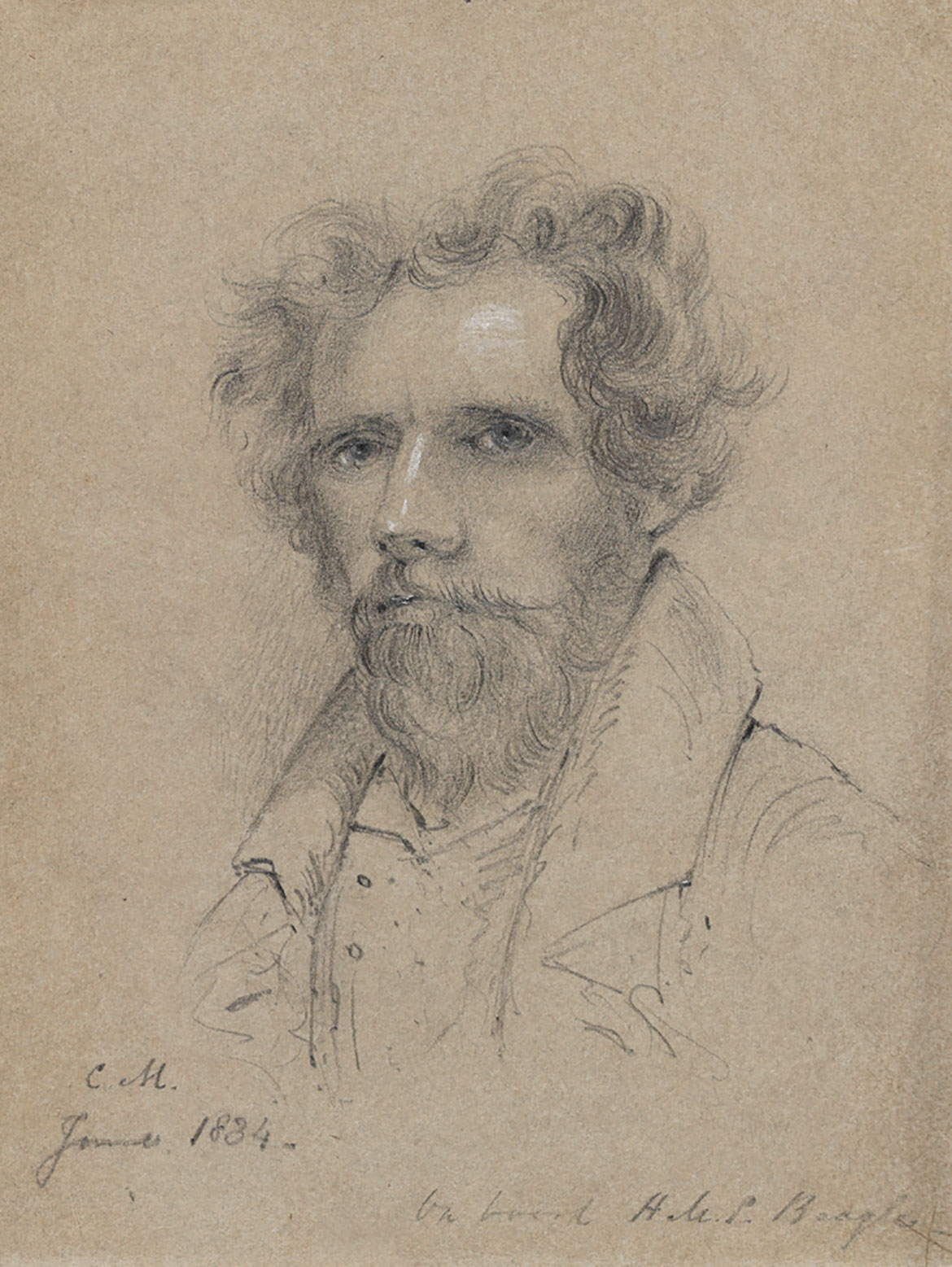
Parker King put work Martens’s way, commissioning paintings of his own property and introducing him to friends, including his sister and brother-in-law, Anna Maria and Hannibal Macarthur, who commissioned paintings of their home at Parramatta. Martens settled in the fashionable Rocks area, set up a studio and started taking on pupils, by 1837 he was married. By 1847, Anna Maria and Hannibal’s daughter Emmeline married George Leslie, the youngest of three brothers who were the first squatters on the Darling Downs, thus setting the stage for their travels north to Queensland.
In 1839 the eldest bother, Patrick Leslie was the first pioneer to establish a European presence on the Darling Downs setting out from Sydney in search of new land to settle, the first wave of pastoral activity in Queensland, at that time the Moreton district of New South Wales. Following the overland trail north via New England — established by his friend Allan Cunningham, who had named the Darling Downs in 1827 — and in 1840 drove his flock of sheep north and registered a squatting run. The Leslie brothers (Patrick, Walter and George) came from Aberdeenshire, where their father William was ninth Laird of Warthill. They were brought up in a rural world of sheep, cattle and horses, and of long distances between neighbours, this proved good training for pastoral life on the Darling Downs.
Map of Canning Downs station c.1865
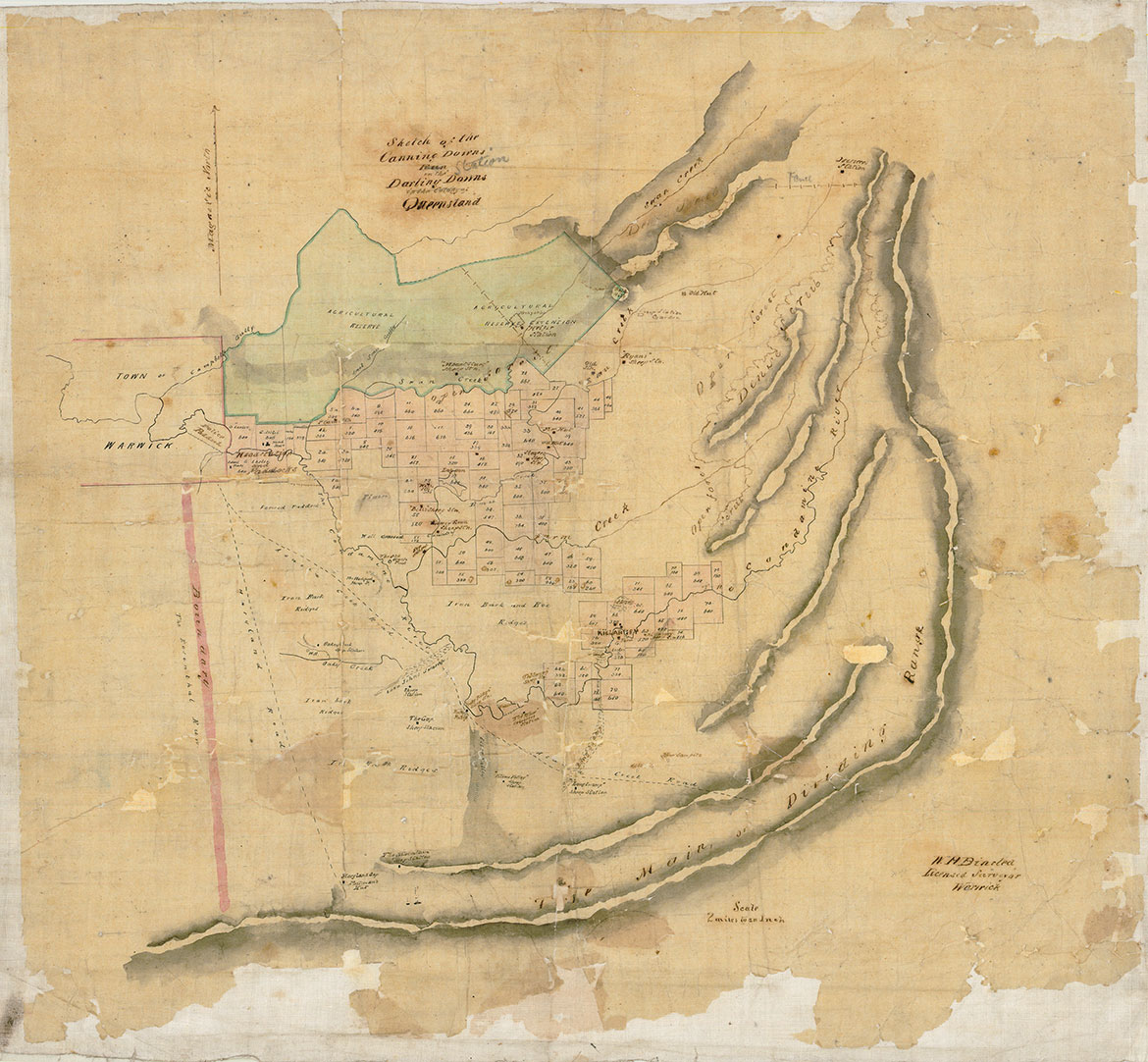
Martens visited the Darling Downs between 7 November 1851 and 19 March 1852, travelling on horseback from station to station, sketching as he went. Twice during this time he visited Canning Downs, the home of his friends George and Emmeline Leslie. The homestead, Cannings Downs and Coochin Run were among works commissioned by George Leslie before the lease was sold to a cousin, Gilbert Davidson. He based his final works on his detailed pencil sketches, which he later worked up into watercolour or oil paintings, often basing the colours on notes made directly on the sketches.
The Squatter Families
The first Europeans to settle the Darling Downs arrived in the early 1840s. By 1851, when Martens crossed Cunningham’s Gap, nearly all the land had been taken up by a small, close-knit group of young men, the squatters of the Darling Downs.

The squatters entered the Downs from New England, driving sheep along the route established by Cunningham which was first used as a stock route by Patrick Leslie. The Downs pastoralists retained close links with family and friends in the south, and these helped Martens, for he knew many squatters and their wives. For instance, besides George marrying Emmeline, Patrick had married Kate Macarthur; the sisters were already well known to Martens before his northern journey, as he had painted ‘Vineyard’, their family home at Parramatta. Anna Macarthur, another of the sisters, married Captain John Wickham of Newstead House, the Police Magistrate in Brisbane who was one of Martens’s old shipmates from HMS Beagle. With all these friends and contacts from Sydney in the northern districts, Martens could be confident of obtaining commissions in Brisbane and the Darling Downs.
Most Downs squatters were recent immigrants — Scottish, Anglo-Irish, and English. Most were younger sons, from the gentry rather than aristocrats, and many relied on family contacts ‘at home’ for financial backing. This was an incentive to buy paintings to record their property, and as gifts for absentee partners in Britain or Sydney.
By 1851 the fortunes of the Darling Downs squatters were rising. They were no longer technically ‘squatters’ — legal changes in 1847 and 1848 allowed them to purchase pastoral leases. With greater security of tenure, they built and decorated fine homesteads, marking their permanence and prosperity, and by commissioning paintings from Martens the colonists invested in pictorial records of their achievements.
Conrad Martens portrait 1853

‘The homestead, Canning Downs’ 1852
The homestead, the main house on a large landholding running livestock, together with its associated outbuildings resembled small villages with their cluster of buildings. Queensland pastoral settlements were initiated by the expansion from New South Wales into the Darling Downs and by 1844 there were at least 30 squatting stations.
The view of the Canning Downs homestead (illustrated) served two purposes, recording the home of a gentleman and celebrating the achievement of establishing a property. However modest the dwelling, or strenuous the squatter’s life, documenting his property by employing an artist was an essential European custom that was continued in the Australian colonies.
Homestead buildings
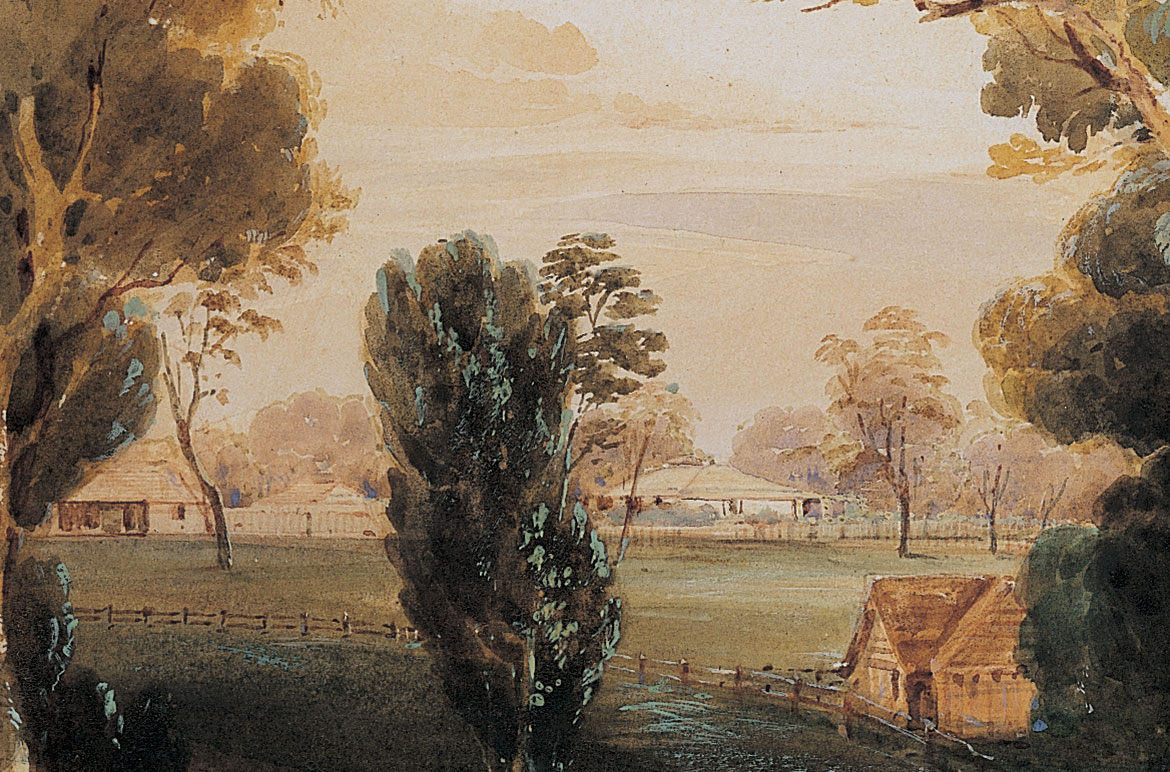

The first dwelling on the Canning Downs site was a modest bark and slab hut built in 1841 by the Leslie brothers Patrick and Walter, it was the centre of their vast property, originally over 100 000 acres. George Leslie’s marriage to Emmeline led to many improvements with the new homestead built in 1845-46. The cottage was built of wood, painted white and inside was lined with canvas and room wallpaper, and surrounded by a verandah. Emmeline brought with her such attributes of cultivated society as a piano, and she planted fruit trees, flowers and vegetables in her cherished garden. The homestead, Canning Downs 1852 shows the fence around the garden, the homestead built by George for Emmeline, and the original slab hut in the foreground, and a woolshed and boiling-down works in the distance.
Pencil sketch 1852
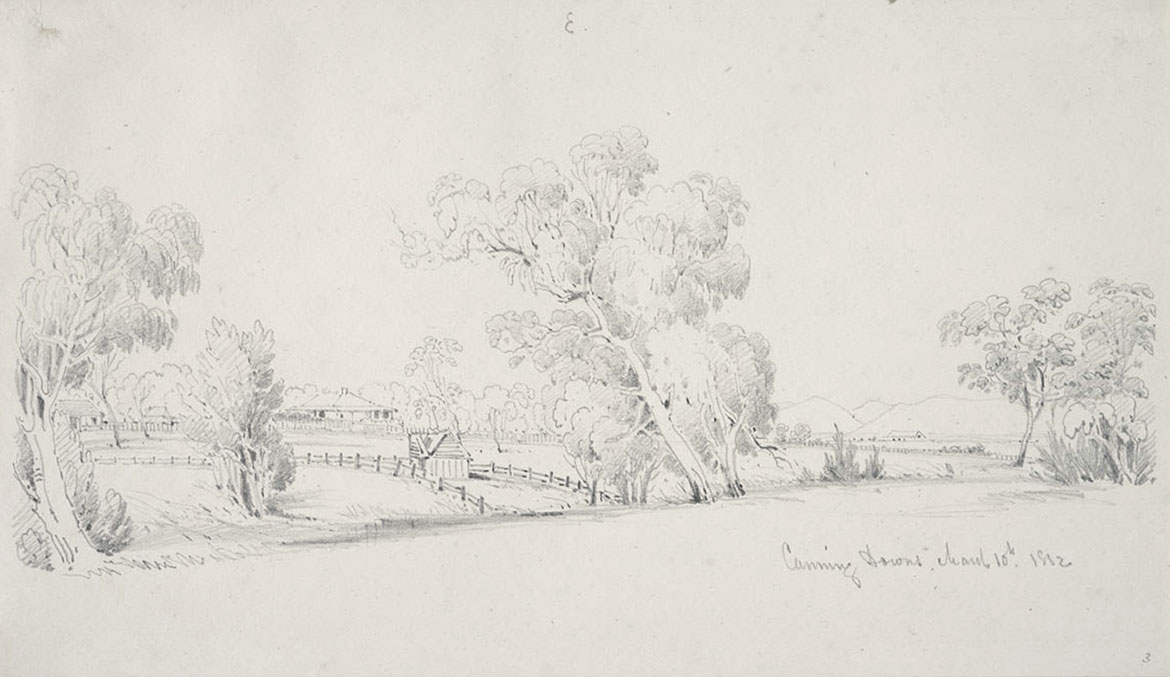
Watercolour 1852
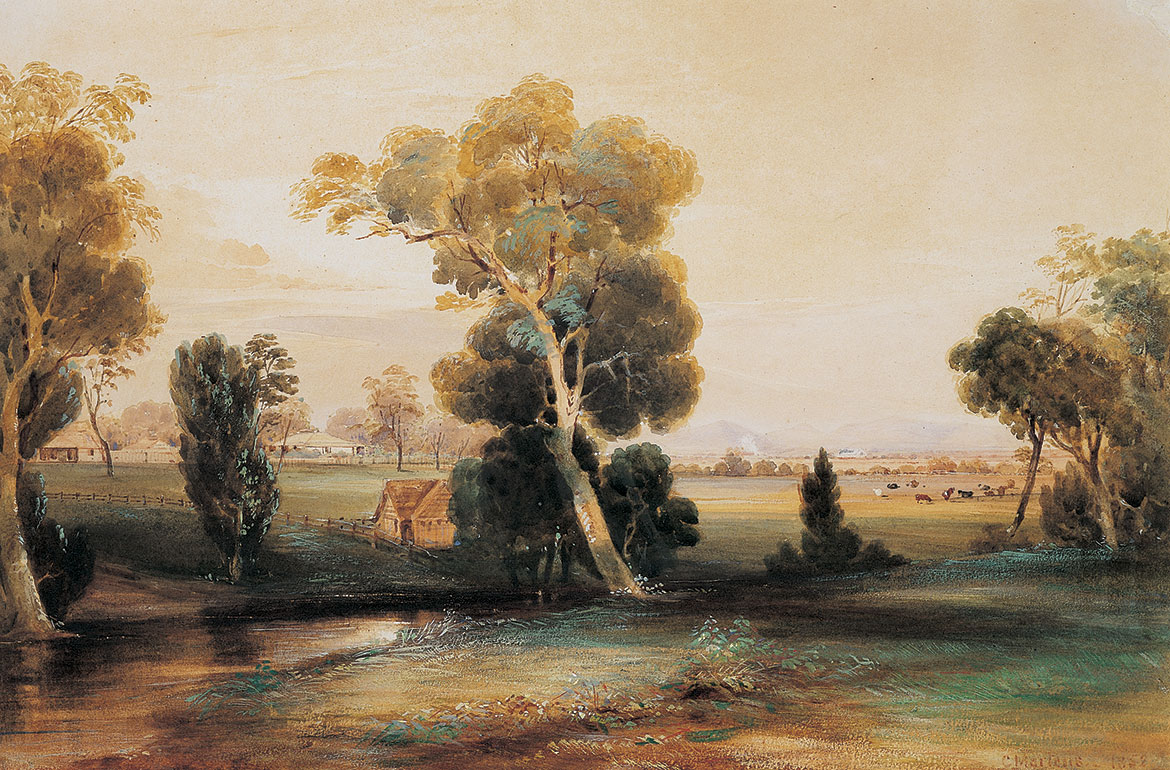
‘Coochin Run’ 1854
Coochin Run is nearly 60 kilometres east from Canning Downs, at one time the run was leased by George Leslie as a resting place for his stock on the journey to and from Brisbane, during Martens visit the owner was George Fairholme, a close friend and pioneer settler of the region.
Coochin Run 1854 can be compared with Martens drawing of a similar view Coochin in 1851. In the foreground are delicate details of trees, grasses and flowers, with a solitary bird, probably a brolga, standing sentinel by the pond — Emmeline kept a pet brolga at Canning Downs. The foreground frames the plains and grazing cattle beyond, with Mount Moon in the distance. Martens sketched remarkably accurate topographical outlines of the mountains in the area and the nearby Great Dividing Range and the Macpherson Range. The view gives some sense of the vast expanses which the squatters had claimed.
Pencil sketch 1851

Watercolour 1854
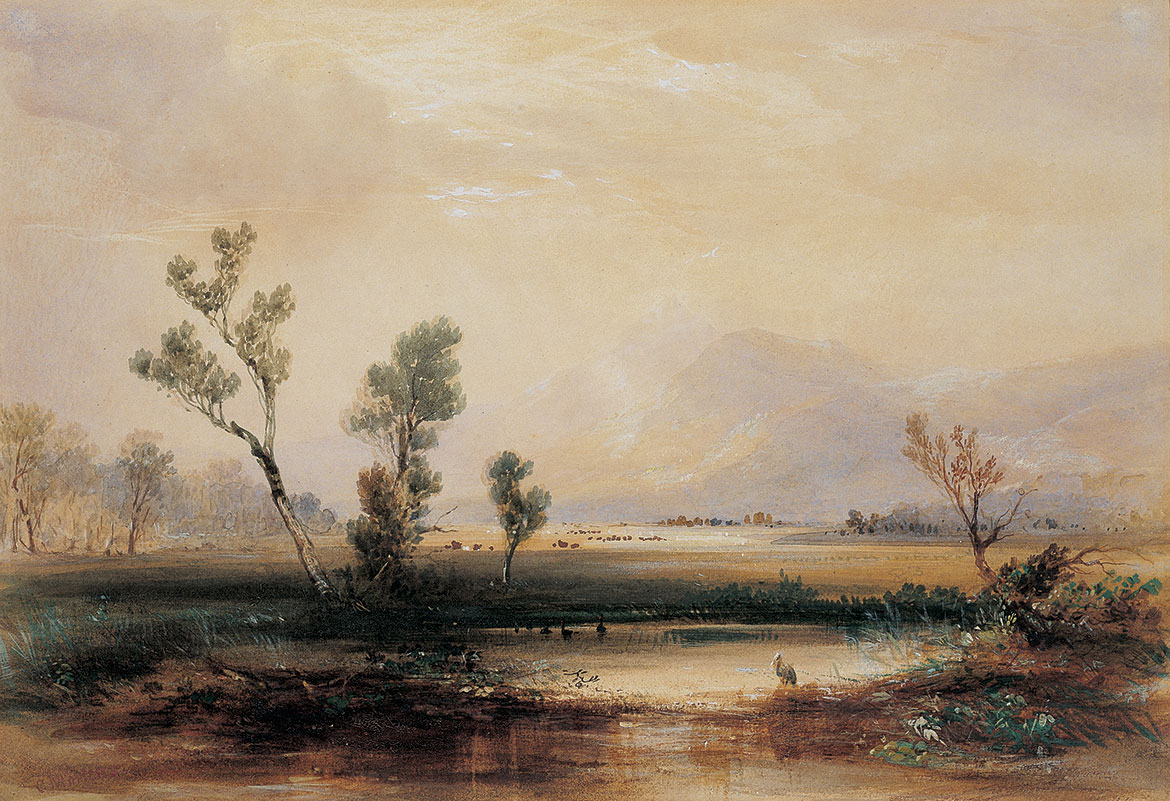
Photographs of Coochin

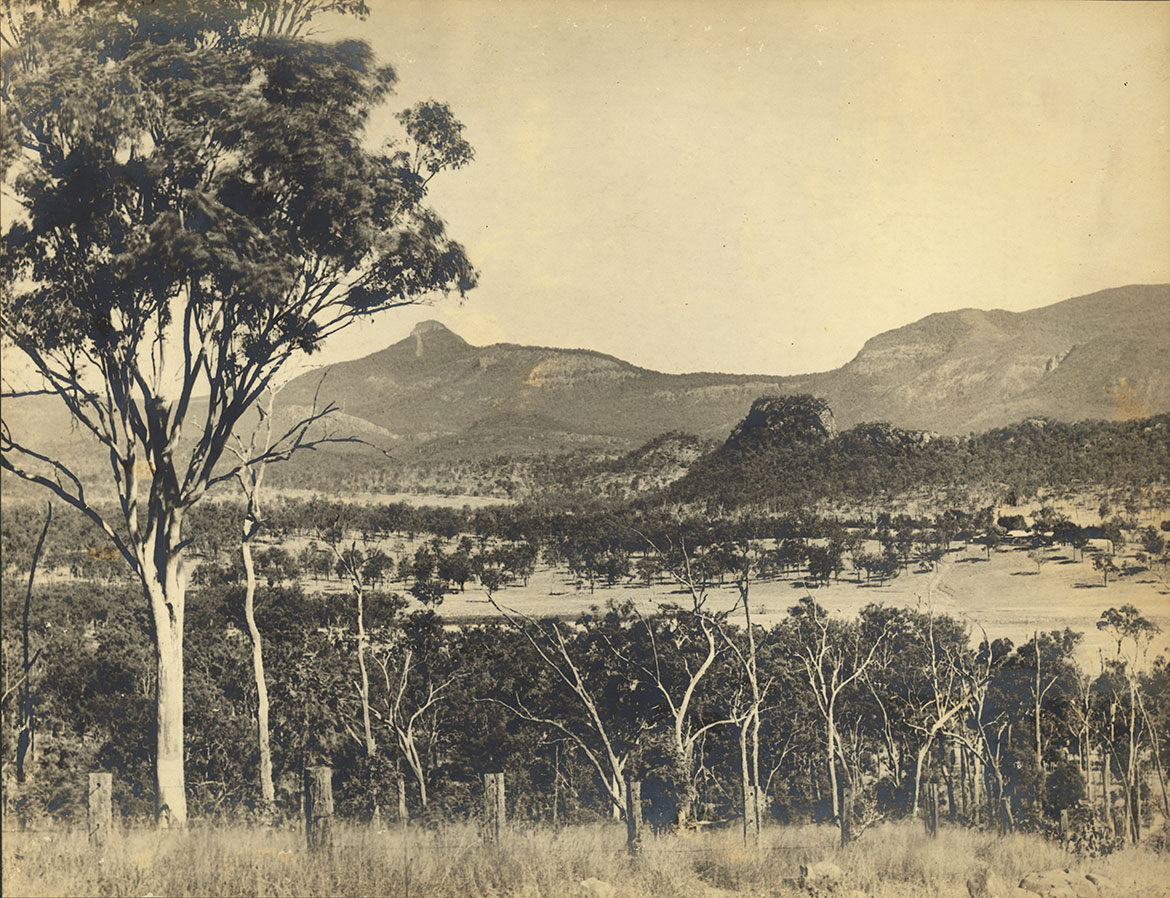
Australian School 1880s
View from Main Range near Spicers Peak, Queensland, Australia, in its detail and bright colours, reflects the artistic concerns of the 1880s, although the artist of the watercolour is unknown, the work is competently executed which suggests professional training in a discipline required to provide clients with accurate visual representations. The watercolour is of a similar quality and was produced at about the same time as a group of watercolours by George Seymour Owen (illustrated).
‘View from Main Range near Spicers Peak’ 1880s
View from Main Range near Spicers Peak is of special interest to QAGOMA as it documents an area that Conrad Martens passed through some thirty years earlier. Spicers Gap is still a major access route to the Darling Downs, the mountains have been identified, from the left, as Moon, Maroon, May and the east and west peaks of Mount Barney, Mount Barney being the second highest peak in south-east Queensland. Mount Barney National Park was gazetted on 6 September 1947, extended to include Mount May and Mount Maroon in 1950, and incorporated Mount Lindesay National Park in 1980. Most of Mount Barney National Park is in the Gondwana Rainforests, listed in 1986 as one of the World Heritage sites for Australia.

George Seymour Owen
Little is known about George Seymour Owen (1844-1921), an engineer and bridge builder by profession, he spent his life building bridges in Australia, South Africa and North America, and as his watercolours show, like many educated people of his time, he was also an adept draftsman. Drawing and watercolour painting of the landscape were key scientific disciplines in this period during the infancy of photography for recording topographical subjects. As a professional engineer, Owen would have been expected to be able to provide accurate landfall drawings of sites being considered for construction projects.
‘House under Bowen Terrace, Brisbane’ 1889
Owen’s works provide an accurate record of the early heritage of Brisbane and the Moreton Bay area. This painting of a cottage in inner-city Bowen Terrace is a detailed representation of a home in the young township of Brisbane, it shows the cliff, along which Bowen Terrace runs, rising behind the cottage. Owen’s works are of considerable significance to Queensland as they are quite rare, amongst the earliest depictions of the Brisbane area at its time of settlement.
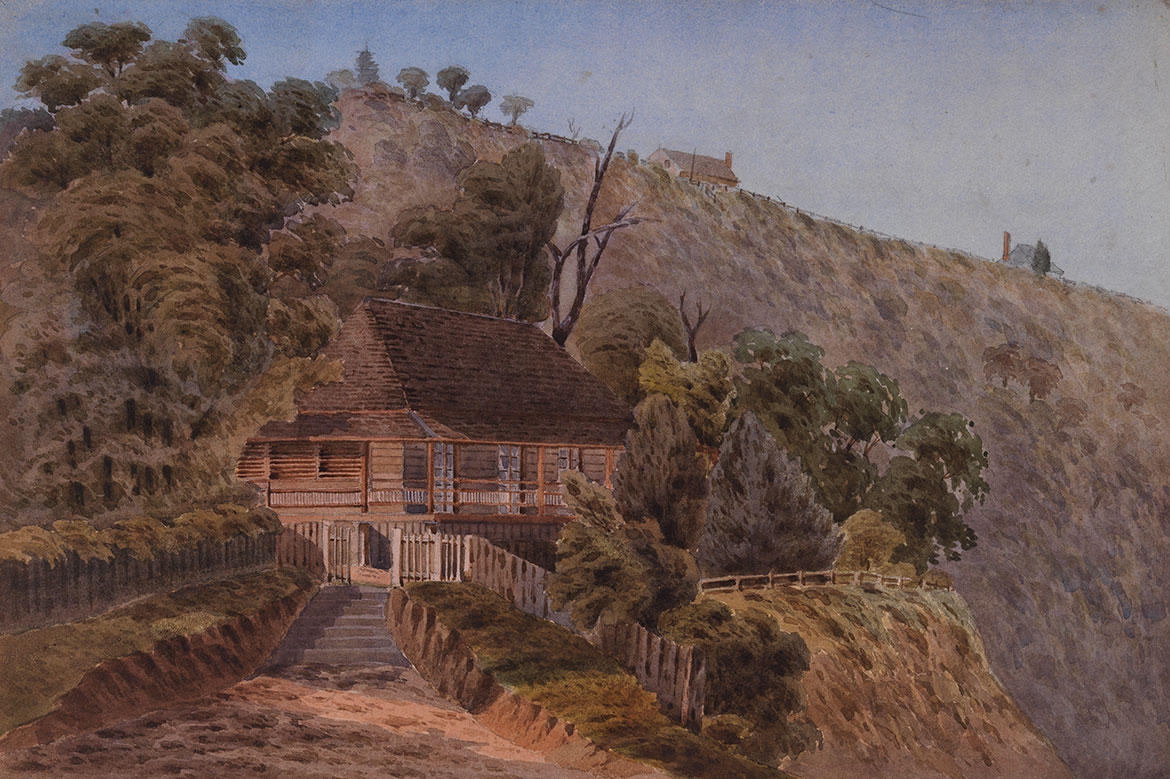
Bowen Terrace cliffs, Petrie Bight c.1880s
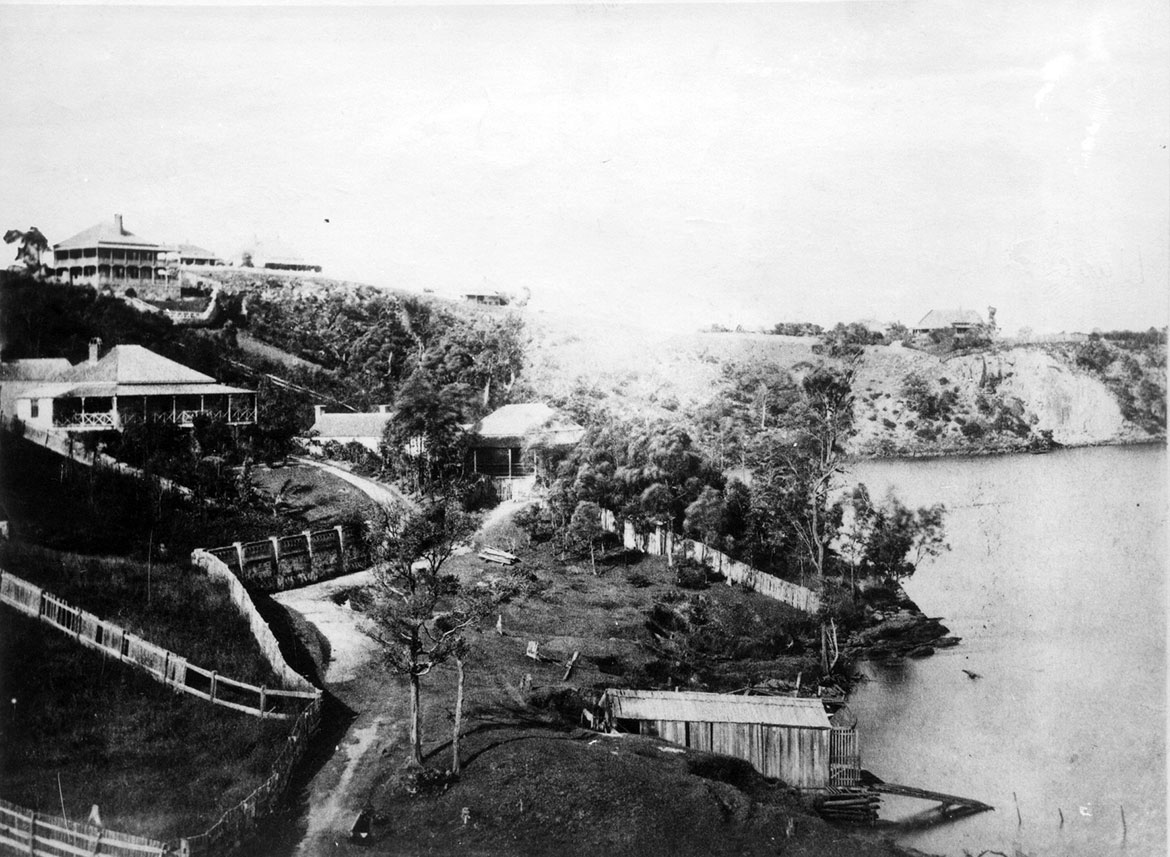
‘A farmstead on Lytton Road, Bulimba’ 1889
This watercolour shows a newly settled area of the infant Brisbane town, depicting a small farm settlement located on Lytton Road, Bulimba and surrounding bushland. In the 1820s Bulimba — located directly opposite the river from Newstead and Hamilton — was settled as a farming district, with residential subdivision commencing in the 1880s land boom. It is a beautifully executed painting which provides an example of the domestic arrangements of the early inhabitants in the outskirts of early Brisbane.
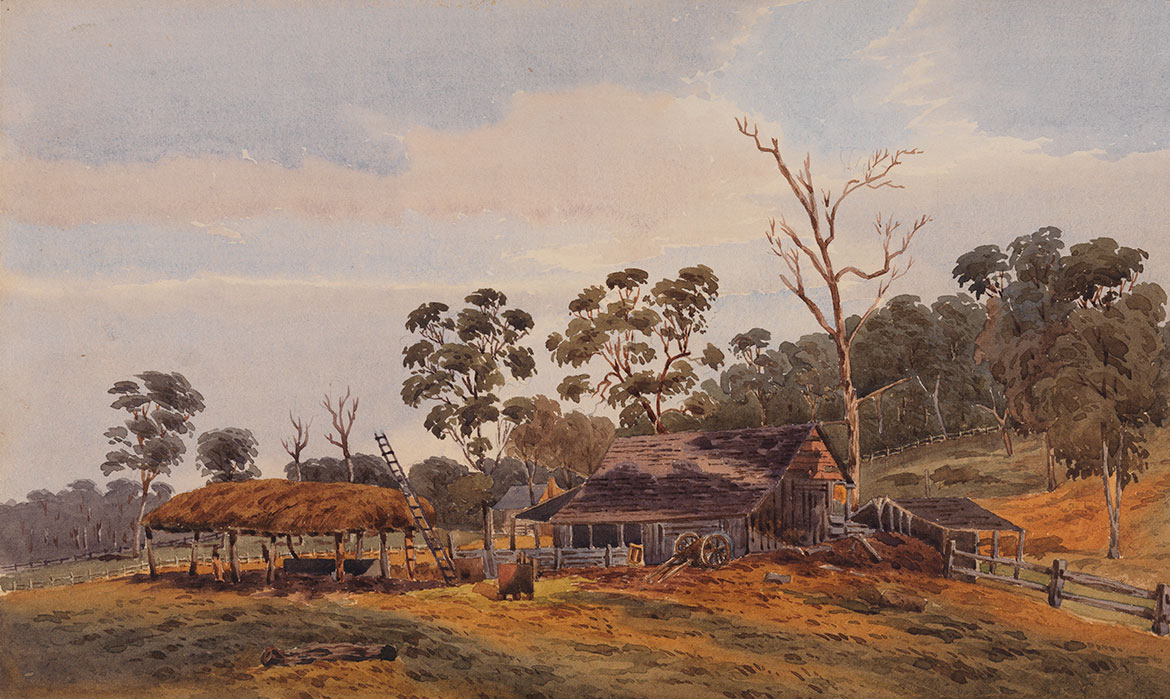
Photographs of Bulimba


Map of Brisbane 1886 highlighting Bowen Terrace and Bulimba
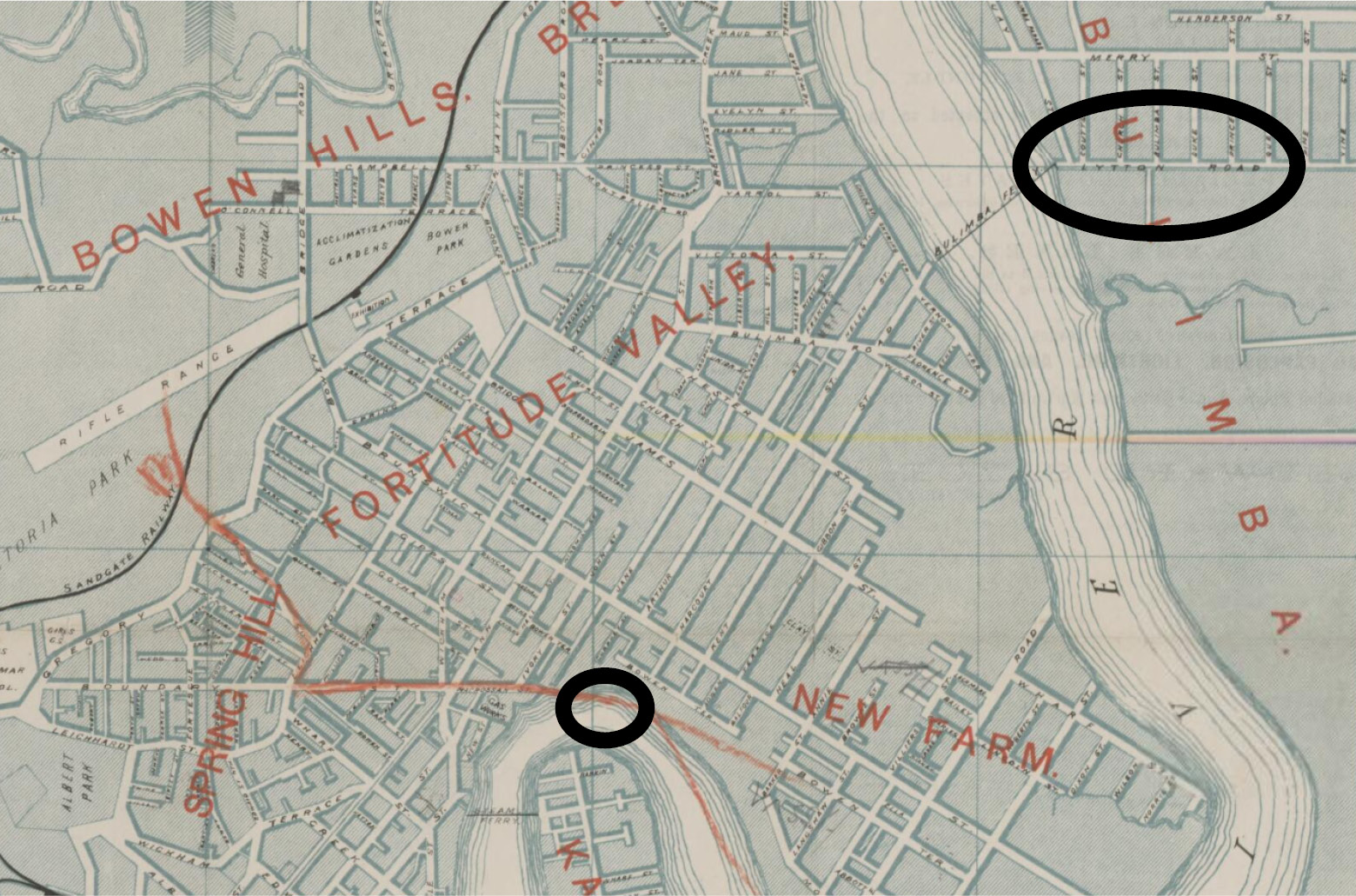
Edited extracts from ‘Northern Journey: Conrad Martens in early Queensland‘.
Additional research and supplementary material by Elliott Murray, Senior Digital Marketing Officer, QAGOMA
Featured image detail: Conrad Martens The homestead, Canning Downs 1852
#QAGOMA
